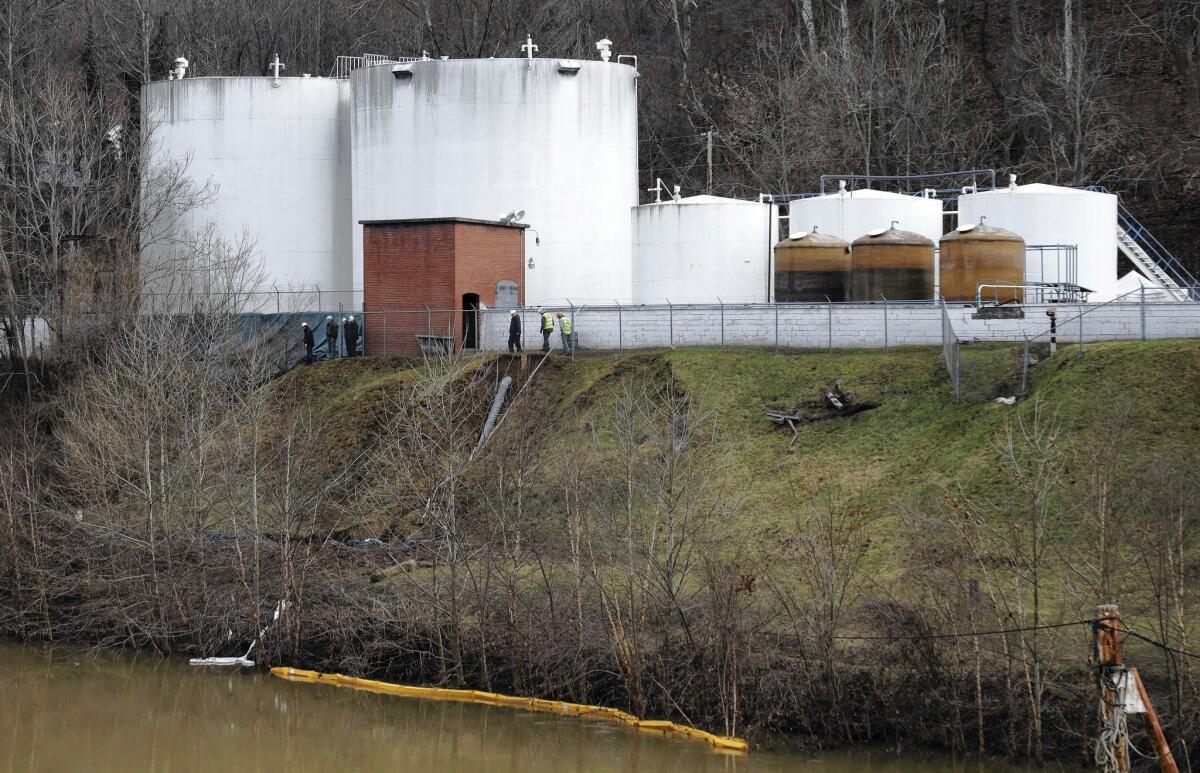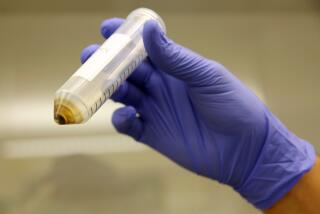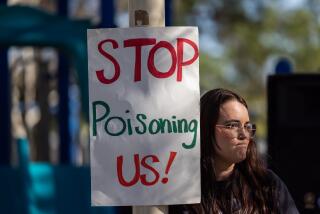West Virginia puzzled, outraged over chemical leak

Few people in West Virginia had any idea that an obscure company was storing a mysterious coal-washing chemical in tanks overlooking the Elk River, just upstream from a major water treatment plant.
Nor did many realize that no agency had conducted regular inspections of those tanks, even though they are perched on a steep bank that tumbles down to the river northeast of downtown Charleston.
On the morning of Jan. 9, residents complained about a licorice-like odor wafting from the site, operated by a chemical company with the unlikely name of Freedom Industries. When state inspectors arrived to investigate, they discovered that one of the tanks had ruptured and dumped the little-known chemical 4-methylcyclohexane methanol, known as MCHM, into the river.
The inspectors also discovered something else: Freedom Industries had not taken action to stop the leak or report it to authorities, according to the state Department of Environmental Protection. As it turned out, there are virtually no regulations governing inspection and maintenance of the storage tanks.
“I can’t believe there is not a law against what they did,” Charleston’s outspoken mayor, Danny Jones, said in an interview. He called the chemical company “a bunch of renegades who have done irreparable harm to this valley.”
“Quite frankly,” he said, “somebody needs to go to jail.”
At least 7,500 gallons of the foaming agent cascaded past a containment area and poured into the Elk River. The spill left more than 300,000 residents of Kanawha County, which includes Charleston, and eight surrounding counties without water after the governor issued an emergency do-not-use order. People couldn’t use tap water to drink, bathe, brush teeth or wash dishes or clothes. Boiling it would do no good. The U.S. attorney’s office in Charleston has begun an investigation.
It was hardly the first accident to spew dangerous chemicals in West Virginia, where the economy is built on the coal and chemical industries. Despite periodic accidents, the two industries have teamed with politicians in a deeply conservative state (Mitt Romney won 62% of votes in the 2012 presidential election) to fight environmental regulations.
The Department of Environmental Protection last inspected the tanks in 1999, when the site was owned by an oil company. The tanks at the time contained “hazardous waste-generating” oil products, department spokesman Tom Aluise said in an interview. But the tanks now hold chemicals and do not require state inspections because they don’t contain material considered hazardous, he said.
Federal inspections are not required because “atmospheric tanks” like the one operated by Freedom Industries are exempt under federal safety inspections because they are not under pressure, cooled or heated — and are not involved in chemical processing, according to the U.S. Chemical Safety Board.
“They fall through the cracks,” Daniel M. Horowitz, managing director of the board, which has advocated revising the regulations, said in an interview.
Little is known about the possible health effects of MCHM, a solvent used to wash impurities from coal. For days after the spill, state officials were at a loss to explain to residents just what was in the stuff and just how dangerous it might be. Authorities said it was not lethal, but could cause vomiting, nausea and skin, eye and throat irritation.
As bottled water supplies sold out in many areas within hours of the governor’s edict, thousands of residents lined up to collect emergency bottled water or fill makeshift containers from water tankers towed in by the West Virginia National Guard. Day after day, residents went without showers as authorities scrambled to test the water to ensure it met the federal safety standard of less than one part per million of the contaminant.
But that standard was challenged by Richard Denison, a senior scientist at the Environmental Defense Fund. He said the U.S. Centers for Disease Control and Prevention violated its own procedures by relying chiefly on a lab rat study by the chemical manufacturer to set the standard. He called the study, in which he said MCHM was fed to rats until they died, “crude,” “very problematic” and based on “shaky science.”
Dr. Vikas Kapil, a senior CDC official, defended the standard as valid. But he added, “There are uncertainties, and there is very little information on this chemical.” He said the agency was reviewing a second MCHM study it had obtained.
The CDC on Wednesday warned pregnant women not to drink water, even though state officials have declared the water safe for 150,000 people in some affected districts, based on the CDC standard. Kapil said the warning was issued “out of an abundance of caution.”
In a letter to the CDC on Thursday, Sen. Joe Manchin III (D-W.Va.) and Rep. Shelley Moore Capito (R-W.Va.) said they were “deeply disappointed” in the agency for causing “confusion, fear and mistrust” regarding its safety standard. They requested details of CDC studies.
Maranda Demuth of the MCHM manufacturer, Eastman Chemical Co. in Tennessee, said the company was providing complete toxicity studies for the chemical to all agencies and first responders who requested them after the spill. The company’s tests were conducted “by reputable laboratories in accordance with established standards,” Demuth said.
As an established chemical at the time of the 1976 Toxic Substances Control Act, MCHM is exempt from its regulations, which applies to new chemicals. A document on the Eastman Chemical website says of MCHM: “Harmful if swallowed, causes skin and eye irritation.”
“MCHM wasn’t on anybody’s radar screen until this accident,” said Horowitz of the U.S. Chemical Safety Board. He also said most local residents were barely aware of the chemical facility because the tanks are “very ordinary looking, just storage tanks on a concrete pad.”
“One might assume the chemical stored inside is not hazardous — until it spills into the drinking water,” he said.
As Charleston residents lined up for water, often in the rain or in darkness, they fumed at the chemical company and asked how it could be allowed to let a dangerous and poorly understood chemical leak into their tap water.
“They didn’t maintain their product like they should have, and it’s affected a lot of people’s lives,” Chuck Fulks, 59, a construction company employee, said as he loaded emergency water into his pickup in the parking lot of an industrial plant in Charleston. “It looks like they didn’t follow regulations.”
In Chemical Valley, as the area around Charleston is sometimes called, regulation can be a dirty word. The chemical industry provides at least 9,950 jobs directly and 27,000 related jobs, according to the American Chemistry Council. The region’s industry generates a $747-million payroll and pays $117 million in federal taxes and $72 million in state and local taxes, according to the trade group.
Mayor Jones said many residents had complained to him since the spill that the chemical company wasn’t properly regulated. He said he was not sure more regulation was the answer.
“Maybe we just need the people who are supposed to enforce the laws to enforce them,” he said.
Aluise of the state Department of Environmental Protection said Freedom Industries was required by law to immediately report the leak and to take action to stop it. The company did neither, he said. On Monday, the state agency cited the company for five safety violations, saying containment walls at a new site where Freedom has moved the chemicals were riddled with holes.
When a 2008 explosion and fire killed two workers at the Bayer CropScience plant in Institute, W.Va., the Chemical Safety Board recommended new procedures to help prevent chemical accidents. Those recommendations were not adopted by state environmental and health agencies.
Horowitz said there was “some cautious support early on” from the state and the chemical industry after the 2008 incident. “But there hasn’t been much concrete action,” he said.
The safety board also made recommendations after a 2010 phosgene leak at a DuPont plant in Belle, W.Va., that killed one worker. Prior to the leak, federal regulators had not inspected the plant for five years. The plant later complied with the recommendations.
Asked about last week’s spill, Anne Kolton, vice president of communications for the American Chemistry Council, said the trade group supported attempts to find out what went wrong in Charleston.
“It’s very important to determine whether better enforcement of existing regulations could have helped prevent this incident,” Kolton said. “If careful examination indicates that new steps are needed, ACC will work with Congress to ensure that any new requirements are targeted and minimize unintended consequences.”
Horowitz said one focus of the Chemical Safety Board inquiry would be installation, maintenance and inspection of the storage tanks. Asked whether the board would recommend changes in inspections, he replied, “There is an opportunity for improvement.”
Aluise said the Department of Environmental Protection intended to propose legislation for tougher regulations on chemical storage. In June, the agency asked Eastman about MCHM in response to complaints about odors at the tank site. The agency visited the site five times since 2001 in response to similar complaints but did not inspect the tanks, the Wall Street Journal reported.
Even after the water is declared safe to drink, long-term health effects of exposure to the chemical still won’t be known, said Denison of the Environmental Defense Fund. Among them could be damage to the liver or kidneys, or to a developing fetus, he said.
“We just don’t know because this chemical has never been properly tested,” Denison said. “The data just don’t exist.”
More to Read
Start your day right
Sign up for Essential California for news, features and recommendations from the L.A. Times and beyond in your inbox six days a week.
You may occasionally receive promotional content from the Los Angeles Times.







